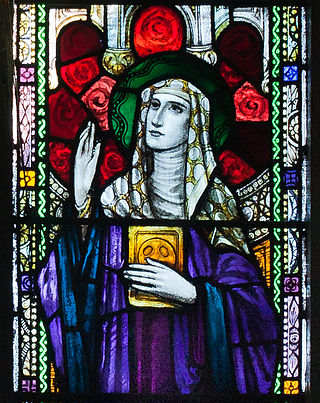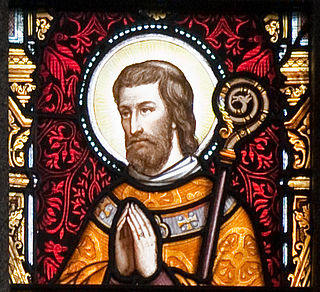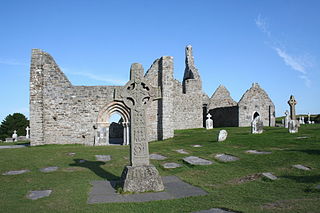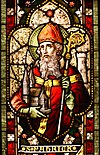Related Research Articles

Íte ingen Chinn Fhalad, also known as Íde, Ita, Ida or Ides, was an early Irish nun and patron saint of Killeedy. She was known as the "foster mother of the saints of Erin". The name "Ita" was conferred on her because of her saintly qualities. Her feast day is 15 January.

Saint Molaiseof Leighlin, also Laisrén or Laserian, was an early Irish saint and abbot of Lethglenn or Leithglenn, now Old Leighlin in County Carlow, who is supposed to have lived in the 6th and 7th centuries. In Scotland, he is known as "Molaise" while in Ireland he is revered as "Laserian".

Coolock is a large suburban area, centred on a village, on Dublin city's Northside in Ireland. Coolock is crossed by the Santry River, a prominent feature in the middle of the district, with a linear park and ponds. The Coolock suburban area encompasses parts of three Dublin postal districts: Dublin 5, Dublin 13 and Dublin 17.

Raheny is a northern suburb of Dublin, Ireland, halfway from the city centre to Howth. It is centred on a historic settlement, first documented in 570 AD. The district shares Dublin's two largest municipal parks, Saint Anne's Park and Bull Island with its 4.5 km beach, with neighbouring Clontarf, and is crossed by several small watercourses.

Saint Máedóc of Ferns, also known as Saint Aidan, Saint Madoc or Saint Mogue, was an Irish saint who was the first Bishop of Ferns in County Wexford and the founder of thirty churches. His birth name was Áed, the name of the Irish god of the underworld, meaning "fire". The name Aidan is a diminutive form of Aed or Aodh, and was also a form of the Latin name Dominus. Máedóc and Mogue are other pet forms of Aed or Aodh, formed from the Irish affectionate prefix mo- and the diminutive suffix -óg, meaning "young", making for something like "my dear little Aodh".

Clonmacnoise is a ruined monastery situated in County Offaly in Ireland on the River Shannon south of Athlone, founded in 544 by Saint Ciarán, a young man from Rathcroghan, County Roscommon. Until the 9th century it had close associations with the kings of Connacht.

Clontarf is an affluent coastal suburb on the Northside of Dublin in the city's Dublin 3 postal district. Historically, there were two centres of population, one on the coast towards the city, and the fishing village of Clontarf Sheds, further north on the coast at what is now Vernon Avenue. Clontarf has a range of retail businesses in several locations, mainly centred on Vernon Avenue. It adjoins Fairview, Marino, Killester and Raheny. Clontarf is in the jurisdiction of Dublin City Council.
Kilbarrack is a residential suburb of Dublin, Ireland, running inwards from the coast, about 8 km (5.0 mi) from the city's centre. It is also a civil parish in the ancient barony of Coolock. Modern-day Kilbarrack is within the jurisdiction of Dublin City Council, with part of its old lands now in Donaghmede, and part in Bayside under Fingal County Council jurisdiction.

Iarlaithe mac Loga, also known as Jarlath, was an Irish priest and scholar from Connacht, remembered as the founder of the monastic School of Tuam and of the Archdiocese of Tuam, of which he is the patron saint. No medieval biography of Jarlath is extant, but sources for his life and cult include genealogies, martyrologies, the Irish Lives of St Brendan of Clonfert, and a biography compiled by John Colgan in the 17th century.

Saint Moluag was a Scottish missionary, and a contemporary of Saint Columba, who evangelized the Picts of Scotland in the sixth century. Saint Moluag was the patron saint of Argyll as evidenced by a charter in 1544, from the Earl of Argyll, which states "in honour of God Omnipotent, the blessed Virgin, and Saint Moloc, our patron". The House of Lorne became the kings of Dalriada and eventually united with the Picts to become the kings of Scots.

The Twelve Apostles of Ireland were twelve early Irish monastic saints of the sixth century who studied under St Finnian at his famous monastic school Clonard Abbey at Cluain-Eraird, now Clonard in County Meath.

The Archdiocese of Dublin is a Latin Church ecclesiastical territory or archdiocese of the Catholic Church located in the eastern part of Ireland. Its archepiscopal see includes the republic's capital city – Dublin. The cathedral church of the archdiocese is St Mary's Pro-Cathedral. Dublin was formally recognised as a metropolitan province in 1152 by the Synod of Kells. Its second archbishop, Lorcán Ua Tuathail, is also its patron saint.

Saint Féchín or Féichín, also known as Mo-Ecca, was a 7th-century Irish saint, chiefly remembered as the founder of the monastery at Fore (Fobar), County Westmeath.
Eithne and her sister Sodelb are two relatively obscure Irish saints from Leinster who are supposed to have flourished in the 5th century. They are commemorated together in the Irish martyrologies on 29 March, though 2 and 15 January were also marked out as feast-days. The 17th-century scholar John Colgan believed that a Life written for them had been witnessed in c. 1490 by Cathal Óg Mac Maghnusa, whom he regarded as the author of additions to the Félire Óengusso. Although nothing of the kind has come to light, they do make cameo appearances in the Lives of two better-known 6/7th-century saints, Áedan and Moling, both bishops of Ferns.
Events from the 6th century in Ireland.
Raoiriú was an early Irish missionary, c. 500 AD.

Abbán of Corbmaic, also Eibbán or Moabba, was a saint and abbot. He is associated, first and foremost, with the Mag Arnaide. His order was, however, also connected to other churches elsewhere in Ireland, notably that of his alleged sister Gobnait.

Saint Gobhan has long been linked with the parish of Seagoe – recorded for instance as Teach dho-Ghobha – in County Armagh, Ireland.
The Cluain Conmhaícne, or Cluain Conmaicne, were an early people of Ireland. Their tuath comprised the entire parish of Cloone, located in the baronies of Maigh Rein (Mohill) and Carrigallen, in south County Leitrim.
References
- ↑ Plummer 1922, p. 24–25.
- 1 2 "Saint Berach", Kilbarrack Archived 4 November 2013 at the Wayback Machine
- ↑ Coleman, Keith (2022), Áedán of the Gaels: King of Scots, Pen & Sword, Yorkshire, pp. 5 - 7, ISBN 9781526794901
- 1 2 Grattan-Flood, William. "St. Berach." The Catholic Encyclopedia. Vol. 2. New York: Robert Appleton Company, 1907. 11 May 2013
- ↑ St. Berach at sqpn.com Retrieved 5 April 2013
Secondary sources
- Plummer, Charles (1922). Lives of Irish Saints (PDF). Vol. II (Edited from the Original MSS. with Introduction, Translations, Notes, Glossary and Indexes ed.). Oxford at the Clarendon Press.
